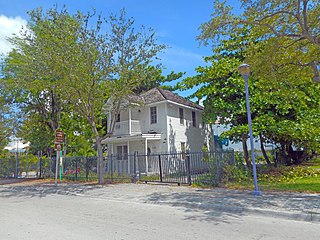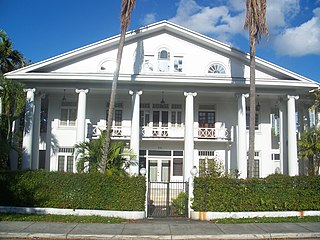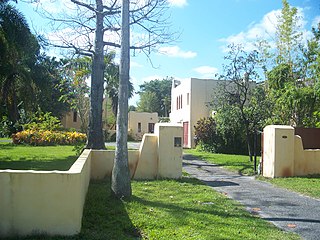
The Freedom Tower is a building in Miami, Florida, designed by Schultze and Weaver. It is currently used as a contemporary art museum and a central office to different disciplines in the arts associated with Miami Dade College. It is located at 600 Biscayne Boulevard on the Wolfson Campus of Miami Dade College. On September 10, 1979, it was added to the U.S. National Register of Historic Places. It was designated a U.S. National Historic Landmark on October 6, 2008, for its role in hosting services for processing Cubans fleeing to Florida. On April 18, 2012, the AIA's Florida Chapter placed the building on its list of Florida Architecture: 100 Years. 100 Places as the Freedom Tower / Formerly Miami News and Metropolis Building.

The Venetian Causeway crosses Biscayne Bay between Miami on the mainland and Miami Beach on a barrier island in south Florida. The man-made Venetian Islands and non-bridge portions of the causeway were created by materials which came from the dredging of the bay. The Venetian Causeway follows the original route of the Collins Bridge, a wooden 2.5 mi (4 km) long structure built in 1913 by John S. Collins and Carl G. Fisher which opened up the barrier island for unprecedented growth and development.
Adams House may refer to:

Arch Creek was an early settlement in Miami-Dade County, Florida, in present-day metropolitan Miami. Tequesta Indians thrived here before the first Europeans arrived in the early 16th century. The name is derived from the 40 feet (12 m) long natural limestone bridge that spanned the creek until 1973. It is part of the Arch Creek Memorial Park at 1855 Northeast 135th Street, on Biscayne Boulevard. It was added to the U.S. National Register of Historic Places on July 15, 1986.

Egmont Key State Park and National Wildlife Refuge is a Florida State Park located on the island of Egmont Key, at the mouth of Tampa Bay. Egmont Key lies southwest of Fort De Soto Park and can only be reached by boat or ferry. Located within Egmont Key State Park are the 1858 Egmont Key Lighthouse, maintained by the U.S. Coast Guard, and the ruins of Fort Dade, a Spanish–American War era fort that housed 300 residents. Egmont Key is located in Hillsborough County Florida on a narrow strip of the county that extends along the Tampa Port Shipping Channel.

The Miami-Dade County Courthouse, formerly known as the Dade County Courthouse, is a historic courthouse located at 73 West Flagler Street in Miami, Florida. Constructed over four years (1925–28), it was added to the U.S. National Register of Historic Places on January 4, 1989. The building is 361 feet tall with 28 floors. When it was built, it was the tallest building in Miami and in Florida.

The Old U.S. Post Office and Courthouse is a historic courthouse in Miami, Florida. It is located at 100-118 Northeast 1st Avenue. Constructed over three years (1912–14), it was designed by Kiehnel and Elliott and Oscar Wenderoth. It was added to the U.S. National Register of Historic Places on January 4, 1989. The Miami-Dade County Tax Records say this building was built in 1917 .

The Miami Edison Middle School is a historic school in Miami, Florida. It is located at 6101 Northwest 2nd Avenue. On June 5, 1986, it was added to the U.S. National Register of Historic Places. Edison Closed its Doors in 2015, to make way for New iTech @ Thomas A. Edison Educational Center.

The Southside School is a historic school in Brickell in Downtown Miami, Florida. It is located at 45 Southwest 13th Street. On January 4, 1989, it was added to the U.S. National Register of Historic Places.

The D. A. Dorsey House is the historic home of D. A. Dorsey in Miami, Florida. It is located at 250 Northwest Ninth Street. On January 4, 1989, it was added to the U.S. National Register of Historic Places.

The J. W. Warner House is a historic home in Miami, Florida. It is located at 111 Southwest 5th Avenue. On June 1, 1983, it was added to the U.S. National Register of Historic Places.

The Coral Gables Merrick House is a historic house located at 907 Coral Way in Coral Gables, Florida.

The Hequembourg House was a historic home in Miami Springs, Florida. It was located at 851 Hunting Lodge. On November 1, 1985, it was added to the U.S. National Register of Historic Places, but was removed from the Register in January 2011. It was a work of Curtiss & Bright.

The Millard–McCarty House is a historic home in Miami Springs, Florida. In 1986 it was added to the National Register of Historic Places. It is located at 424 Hunting Lodge, within a development by Curtis and Bright.

The Lua Curtiss House I is a historic home in Miami Springs, Florida. It is located at 85 Deer Run. On November 1, 1985, it was added to the U.S. National Register of Historic Places. It was a work of Curtiss & Bright.

The Lua Curtiss House II is a historic home in Miami Springs, Florida. It is located at 150 Hunting Lodge. On November 1, 1985, it was added to the U.S. National Register of Historic Places. It was a work of Curtiss & Bright.

The Walgreen Drug Store is a historic site in Miami, Florida. It is found at 200 East Flagler Street.

This is a list of the National Register of Historic Places listings in Miami-Dade County, Florida.

August Geiger was one of the most prominent American architects in South Florida from 1905 to the late 1940s. He experimented in Mission, Neo-Renaissance and Art Deco architecture, but is most noted for his works in the Mediterranean Revival style. A number of his works are listed on the U.S. National Register of Historic Places.
Martin Luther Hampton was an architect in Florida. After studying at the Columbia University in New York he settled in 1914 in Miami. Many of his buildings are listed on the National Register of Historic Places.





















